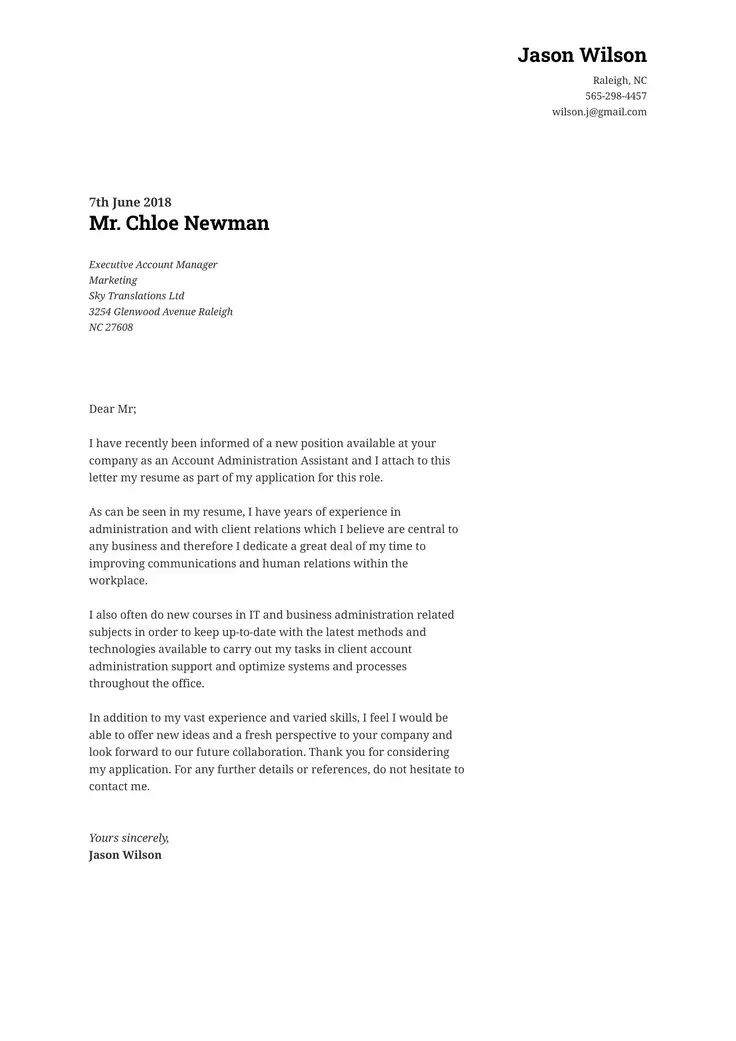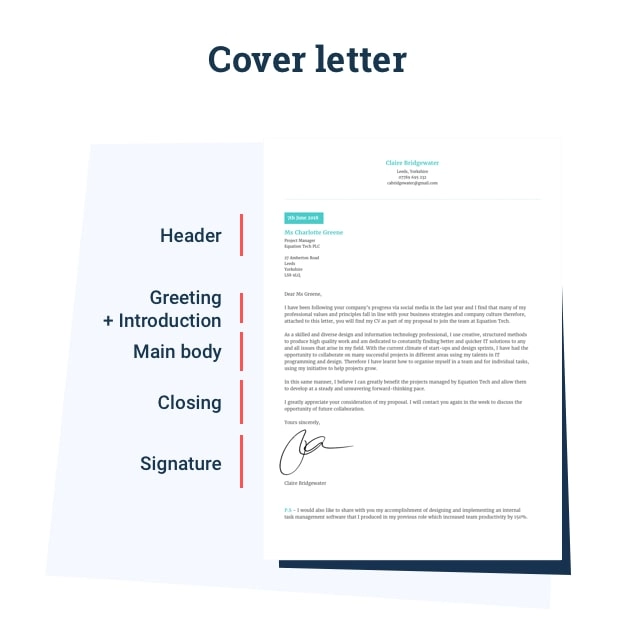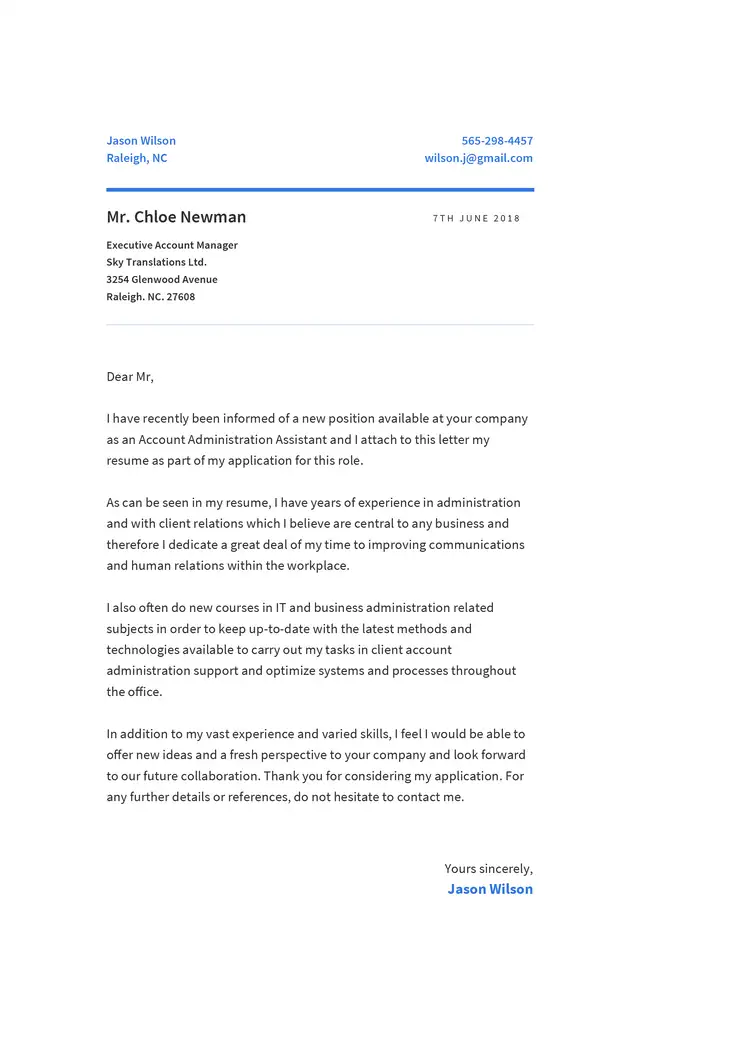The Ultimate Cover Letter Writing Guide
The complete guide to writing an effective cover letter.

When you’re applying for a job, whether it be for an entry-level position after graduating or for a high-level executive vacancy with a professional resume, a good cover letter could be the difference between landing the interview or your application being discarded.
With our complete cover letter guide, you’ll learn how to write a cover letter that will attract the hiring manager and convince them to read your winning resume.
What Is a Cover Letter?
A cover letter is an introduction to the candidate behind the qualifications and experience.
The aim is to show a prospective employer how you can take on the role and what you can offer the company in question. Cover letters generally follow a basic structure and can be in either hard or digital format.
Why Include a Cover Letter on a Job Application?
Including a well-written cover letter is strongly advised by all human resource experts. By definition, a cover letter is an accompanying, explanatory letter.
Without this extra introductory letter, a resume alone could easily be discarded by a hiring manager. CareerBuilder estimates you’re 10% more likely to miss out on an opening if you don’t include a cover letter.
Even if you create an effective, outstanding resume, using all the right keywords and qualifications etc. it’s possible there are candidates more qualified than you or with more experience.
This is why it’s necessary to add a cover letter to back up your resume. It also allows the hiring manager to see more of your personal side that is relevant to the vacancy.
💡Tip
The only time it is acceptable to not include a cover letter in your job application is if the job listing specifically requests that you do not.
Advantages of Writing a Cover Letter
A cover letter directly adds to the likelihood that you are called in for an interview and gives you a better chance of being hired.
If you’re successful in writing an effective cover letter, it will offer you the following advantages:
- Hiring managers will see your added effort and attention to detail
- Demonstrates that you put in the time to learn about the company
- It will add a personal touch to your application
- Demonstrates your communication skills, enthusiasm, and character
- Can be used to emphasize skills, or mention skills that didn’t fit on the resume
- It shows your enthusiasm for the opening
- Hiring managers will become acquainted with your best qualities
- A cover letter can help address gaps in employment or career transitions by allowing you to control how the change is framed.
Knowing exactly what is in a cover letter will ensure that it gives you a major advantage over the other applicants.
What Are the 3 Types of Cover Letters?
Adding a cover letter is almost always essential, but choosing the appropriate letter will also be key. Depending on the job post you are applying for, you will need to select the best type of letter to send along with your resume.
There are 3 types of cover letters that you can send to a hiring manager:
- Application cover letters
- Letters of Interest
- Email Cover letters
The letter you write is influenced by whether you are going to apply for a job directly, citing a referral, or asking about vacancies that are not advertised.
Application cover letter
This is your classic cover letter that you send to a hiring manager when you spot a company advertising a job opening. When you want to directly apply for a position, it is mandatory to send this, unless you are specifically asked not to.
Using this letter, you can mention why you want to work for a specific company and why you are the perfect candidate for the position.
The application cover letter should consist of three to four concise paragraphs.
Letter of interest
Say you notice a company that you would really like to work for. It fits your sector, and you know it offers great benefits and good pay. However, you can’t find any openings that match your skill set.
If that’s the case, you don’t need to sit around and wait for the company to have a job vacancy. You can take action with a letter of interest. This type of cover letter states your interest in being employed by a company that isn’t currently advertising any vacancies.
This type of letter goes by a couple of other names, such as:
- Letter of intent
- Statement of interest
Of course, since there is no vacancy, there is no role you can specifically mention, which is the major difference between a letter of intent and a traditional cover letter. Your objective will be to advertise yourself well enough that an employer will just have to interview you.
-
💡 Our expert says

A letter of interest is a great way to network strategically and demonstrate initiative.
Email cover letters
Over the years, the job application process has shifted to a nearly 100% online hiring process. Due to this, it may be necessary to send your cover letter in an email as part of your job application.
While applying, there may not be an option to upload your cover letter. Or maybe you would just like to send it in the body of your email along with your resume. You can send it in one of two ways, in the body of your email or as an attachment (in PDF).
💡Tip
You can combine the resume and cover letter into a single document, preferably as a PDF, to avoid sending multiple documents to the hiring manager. Some hiring managers may request all application materials to be combined into one document.
How To Write a Cover Letter
A cover letter, although short in length generally, can take time to elaborate as it is important to get it right. Sometimes, due to the scarce space for writing, candidates find it difficult to know what to include in a cover letter and what to leave out.
Below is a step-by-step guide to help you get started:
Step 1
To begin writing a cover letter for a job application, candidates should analyze their skills, qualifications, accomplishments and experience to decide which are the most fundamental aspects to include.
Step 2
Next, each jobseeker will have to select the most job-relevant of these elements to include by comparing them with the required or desired qualifications and experience in the job description.
Prioritize the top two to three qualifications and accomplishments that best demonstrate the applicant’s fit for the role.
Step 3
Finally, the applicant should choose some memorable examples that demonstrate evidence of each element included in their cover letter, aiming to tell a story that shows their aptitude for each skill or qualification.
These should aim to show measurable impact or learning.
Note that, similarly to resumes, each cover letter should be tailored for the vacancy and company to which it will be sent.
💡Tip
One way to create a winning cover letter is to use our AI online cover letter creator. Our handy and intuitive tool can help you create a comprehensive, professional cover letter from scratch in just a few minutes.
How to Structure a Cover Letter
Similar to a resume format, designing and writing a cover letter has certain rules that should be adhered to in order to convey the necessary information in a brief and to-the-point introductory letter.
Check out some of the cover letter best practices as advised by human resources experts below:
| Section | What to include | Why it matters |
|---|---|---|
| Header | Your name, contact details, date, and the employer’s information. | Provides essential details and looks professional. |
| Greeting | Address the hiring manager by name, or use a professional alternative like “Dear Hiring Manager.” | Personalizes your application and shows effort. |
| Opening paragraph | State the role you’re applying for and show enthusiasm for the company. | Grabs attention and sets the tone. |
| Main body | A few bullet points highlighting key achievements with numbers or examples, followed by a short paragraph linking your skills to the job. | Bullet points make results easy to scan; the paragraph ties them to the company’s needs. |
| Closing paragraph | Thank the employer, reference attached documents, and express interest in an interview. | Leaves a polite, confident final impression. |
| Sign-off | Use a formal closing (e.g., Sincerely, Best regards) and your full name. | Ends the letter professionally. |
The universally accepted cover letter length is no longer than one letter page, with a main body of about 250-300 words.

Get more formatting advice in our guide on how to format a cover letter with tips and information about all aspects of a good cover letter structure.
Now that you’ve an idea of the benefits and general structure, let’s go through how to write each section of a cover letter.
How to start a cover letter
Your cover letter is what is going to grab an employer’s attention, which means the beginning of your letter needs to be written well. With a great start to your letter, you’ll have the hiring manager wanting to keep learning about you and what you can add to their company.
There are 3 key elements you should include at the beginning of your cover letter. Remember to include:
- A header
- Greeting
- Interesting opening paragraph
Starting your cover letter with these 3 things will ensure you end up with a well-made job application. All these parts must include the appropriate phrasing and length, so it’s important to understand exactly what to include.
Cover letter header
This is essential to every cover letter. A letter header must have the following:
- Your name
- Your contact information (phone, email)
- Date
- Name of the employer and their title
- Title of the company you are applying to
Consider adding your title and location. You may even include links to your LinkedIn or Twitter profiles.
-
💡 Our expert’s advice

I would not advise a candidate to add their home address to the cover letter. Employers sometimes look up where an applicant is located and determine if they come from a low or high-income area, which can lead to discrimination against an applicant.
Greeting
With a proper greeting, you can automatically win some points with the employer. It’s a simple strategy that automatically grabs attention. By directly giving a salutation to the hiring manager, you start your letter in a way that’s personal, which is effective.
Depending on the culture of the company, you can decide to use the employer’s first name or last name. If the company is a bit more modern and casual, go ahead and write the first name. If it is more old school or corporate, it would be better to use the employer’s last name.
By greeting the hiring manager directly, you show straight away the letter is specific to the job posting. That means you should investigate as much as you can about a company and the hiring manager.
A typical greeting should be like one of the following:
- Dear Mrs. Matthews,
- Dear Mr. Jimenez,
- Dear Cathy,
- Dear Mr. McGinnis,
That means you should investigate as much as you can about a company and the hiring manager.
One way to find out the hiring manager’s name is to call the reception desk or HR to find the correct person to whom to address the cover letter.
Opening paragraph
Just like writing an essay in elementary school, an introductory paragraph will set up your letter to succeed.
Except, in this case, your employer doesn’t HAVE to keep reading your cover letter or continue with your job application. That’s why it is critical to make sure any hiring manager that reads your cover letter becomes instantly interested within the first few sentences.
So, what are some essential details that you should add to the first few sentences of your cover letter?
- Why the role excites you
- Impressive achievements
- Strong adjectives
- Relevant experience
- The value you bring
- Any personal connections to the company
Have a look at a couple of examples.
Examples of opening paragraphs
Wrong ❌
Regarding your software engineer vacancy, I would like to apply for the position and submit my resume. As an experienced accountant, I am certain that I would add a lot to your company.
This is a very bland opening. It doesn’t mention the company you are applying for and has little to no details.
Right ✅
As a longtime admirer of ABC’s software ingenuity, I was excited to see there was a vacancy for the senior software engineer position. I am certain I can assist with ABC’s current and future projects. I have 5+ years of experience in managing software development teams and creating various successful software for computers and applications.
This is what a hiring manager wants to see. It shows you have experience, know what the company you are applying to is all about, and are exactly what they are looking for.
Being enthusiastic and highlighting your achievements will ensure a hiring manager continues to look over your application.
How to write the main body of a cover letter
The main body of your cover letter is the heart of your application. While the introduction captures attention and the ending leaves a final impression, this section proves why you’re the right candidate.
Employers should be able to see your value at a glance, without digging through long paragraphs.
What to include in the body
- Choose 2–3 of your most relevant achievements.
- Use specific numbers or results wherever possible.
- Show that you have the skills necessary for the role
- Tie each point directly to the needs of the company or role.
- Keep the format clean and easy to scan.
Examples of body paragraphs
Wrong ❌
I have worked in marketing for several years. I have worked on campaigns, managed social media, and worked with budgets. I am confident I can bring value to your company.
This example is vague, repetitive, and forces the hiring manager to guess what you actually achieved.
Right ✅
In my previous role at BrightWave Media, I delivered measurable results that align closely with your company’s focus on digital growth:
- Increased social media engagement by 40% in six months while staying within a 5k budget.
- Implemented an A/B testing strategy that boosted click-through rates by 18%.
- Partnered with cross-functional teams to launch a multi-channel campaign that grew lead generation by 25%.
These results demonstrate not only my ability to create impact, but also my commitment to delivering efficient, data-driven marketing strategies.
Using bullet points here makes your skills and achievements easy to scan. Even if a recruiter is skimming quickly, they can instantly see the value you bring. This helps your application stand out in a stack of cover letters.
Need help adding skills to your resume? You can use our AI skills generator to instantly add your industry’s most sought-after skills to your resume, if you have them.
How to end a cover letter
The way you finish your cover letter is just as important as how you begin. A strong closing paragraph helps guarantee you leave a professional and lasting impression on the hiring manager. This makes it clear you’re a serious candidate for the role.
There are 3 key elements you should include at the end of your cover letter. Remember to include:
- A short and polite thank you
- A clear call to action (interest in discussing the role further)
- A professional sign-off with your name and contact details
Adding these helps guarantee that your cover letter ends on a confident and respectful note.
Closing paragraph
In your final lines, thank the employer for their time and consideration, mention any attached documents, summarize two to three key points from the cover letter, and express enthusiasm for moving forward in the hiring process. Keep it polite and genuine.
Always end with a formal sign-off such as:
- Sincerely
- Best regards
- Yours sincerely
Avoid casual closings like “Cheers” or “Take care”, which can come across as unprofessional and overly friendly.
Examples of cover letter endings
Wrong ❌
I hope you pick me for the job. I think that I would be great at it, and I’m sure you’ll see that if you hire me. Thank you!
This sounds unprofessional, pushy, and vague. It doesn’t thank the hiring manager properly or show enthusiasm in the right way.
Right ✅
Thank you for considering my application for the Web Designer position. I have attached my resume and portfolio for your review and would welcome the opportunity to discuss how my skills can contribute to your team.
Best regards,
[Your name]
This is professional, polite, and confident. It thanks the recruiter, mentions the attachment, and ends with enthusiasm about the next step.
Cover Letter Advice
Check out the following expert cover letter tips to create a winning cover letter that will convince the hiring manager to give you a call:
- Always include an email address that sounds professional in your contact details. Make sure that it’s not your current work email address. Some applicants have created email accounts specifically for job applications.
- Remember to maintain your focus on the needs of the company you’re applying to. Think about what you can bring to the team, not how you will benefit personally.
- Remember to highlight your transferable skills, especially in cases where you may not meet all the required qualities in the job description.
- Each cover letter you send should be tailored to the specific organization and position with the pertinent keywords.
- Add two to three specific examples to demonstrate your capacity to take on the role.
- Tell a story with your cover letter. You can use it to convey more of your personality and passion towards the sector or profession.
- Don’t repeat information or include too many details. Resumes that run over 600 words get rejected 43% faster, and cover letters can easily fall into this trap too.
- Make sure to ask someone to proofread your cover letter for grammatical and spelling errors,unwanted repetition, or any irrelevant information.
An easy and fast way to write an effective cover letter for a job application is to employ an online cover letter creator. This can offer advice on how to complete a cover letter, with examples and HR-approved templates.
Already have the perfect cover letter, and now want to make sure your resume is just as good? You can use our AI resume builder to build a winning resume from scratch, or to optimize your current resume.
Cover Letter FAQs
Take a look at the following frequently asked questions below that can assist you in writing your cover letter.
Employers use your cover letter to review your professional accomplishments, for example, if you’ve been promoted or if you’ve earned an award in your company. They would also like to see your skill set.
A cover letter, in essence, is a summary of your career so far and should show how you can be valuable to the hiring manager’s company.
Keep your cover letter the correct length and include the information relevant to the job posting. Employers also would like to see that a candidate knows about their company and is enthusiastic about possibly working there.
The simple answer to this is no. A cover letter cannot be two pages. Making it that long creates a huge risk that the hiring manager will lose interest.
A good cover letter tip is to make sure your letter remains between half a page and one full page. It should only contain between 250 and 400 words. The letter should also be between three and four paragraphs long.
While these two documents will almost always go together on a job application, they work in different ways. In reality, they are meant to complement each other to give a hiring manager an idea of who you are and what you can offer.
The purpose of a cover letter is to present yourself as an applicant. It’s meant to be more personal as it shows your enthusiasm for the vacancy. You use it to state why you want the position and how you’re perfect for the role.
A resume, on the other hand, is made to present your work experience and skill set. It’s not as personal, but it provides a list of your qualifications and work history that is meant to impress an employer.
You should never put a photo on a cover letter. By having a photo on your cover letter, you can open yourself to discrimination and bias from the employer.
The only reason to add a photo to an application would be if you are specifically asked.

